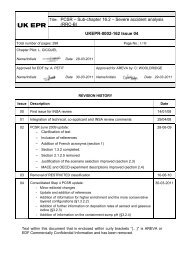14.7 - Fault and Protection Schedule - EDF Hinkley Point
14.7 - Fault and Protection Schedule - EDF Hinkley Point
14.7 - Fault and Protection Schedule - EDF Hinkley Point
Create successful ePaper yourself
Turn your PDF publications into a flip-book with our unique Google optimized e-Paper software.
PRE-CONSTRUCTION SAFETY REPORT<br />
CHAPTER 14: DESIGN BASIS ANALYSIS<br />
SUB-CHAPTER : <strong>14.7</strong><br />
PAGE : 5 / 48<br />
Document ID.No.<br />
UKEPR-0002-149 Issue 02<br />
2. JUSTIFICATION OF THE COMPREHENSIVENESS OF<br />
FAULT PROTECTION<br />
2.1. INTRODUCTION<br />
In this section, the safety measures are identified <strong>and</strong> justified <strong>and</strong> their consistency with<br />
defence in depth concept is explained.<br />
This chapter identifies the safety functional requirements applicable to the safety measures, the<br />
categorisation of the functions, <strong>and</strong> the classification of the systems, structures or components<br />
that contribute to the safety measure. A distinction is made between the lines of defence (first<br />
line consisting of preventative measures, main line consisting of protective measures <strong>and</strong> back<br />
up line consisting of back-up safety measures).<br />
The safety measures described in this chapter are illustrated <strong>and</strong> detailed for each transient<br />
considered, in Sub-chapter <strong>14.7</strong> – Tables 1 <strong>and</strong> 2. For each initiating event, the fault schedule<br />
table gives the associated Plant Condition Category (PCC) or Risk Reduction Category (RRC)<br />
which bounds the resulting fault transient. It also identifies the PCSR section where the fault<br />
transient is considered, <strong>and</strong>, for each phase of the transient, the protection systems which<br />
perform the different required safety functions in the different defence lines.<br />
2.2. DEFENCE IN DEPTH<br />
A defence in depth concept, described in Sub-chapter 3.1, is applied at the design stage of the<br />
EPR. It leads to the implementation of five levels of defence in the engineered safety systems<br />
<strong>and</strong> components, as follows:<br />
• level 1 is a combination of conservative design, quality assurance, high quality of<br />
fabrication <strong>and</strong> high level of surveillance activities (controls, monitoring) to prevent<br />
departures from normal plant operation;<br />
• level 2 consists of the implementation of protection devices which make it possible<br />
to detect <strong>and</strong> correct the effects of deviations from normal operation or the effects of<br />
system failures. This defence level is aimed at ensuring the integrity of the fuel<br />
cladding <strong>and</strong> that of the primary cooling system so as to prevent anticipated<br />
operational occurrences from escalating to accident conditions;<br />
• level 3 consist of safeguard systems, protection devices <strong>and</strong> operating procedures<br />
which make it possible to control the consequences of accidents that may occur so<br />
as to contain radioactive material <strong>and</strong> prevent occurrence of severe accidents;<br />
• level 4 comprises measures aimed at preserving containment integrity <strong>and</strong><br />
controlling severe accidents;<br />
• level 5 includes, in the event of the failure of previous levels of defence, all<br />
measures for protecting the public against the effects of significant radiological<br />
discharges.














![6.3 - Safety Injection System (RIS [SIS]) - EDF Hinkley Point](https://img.yumpu.com/42739985/1/184x260/63-safety-injection-system-ris-sis-edf-hinkley-point.jpg?quality=85)


